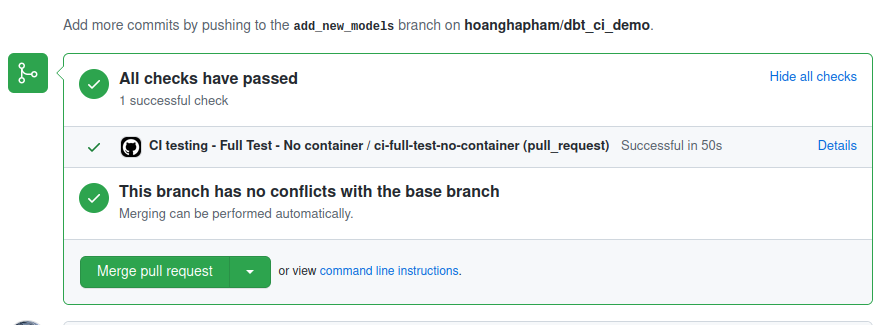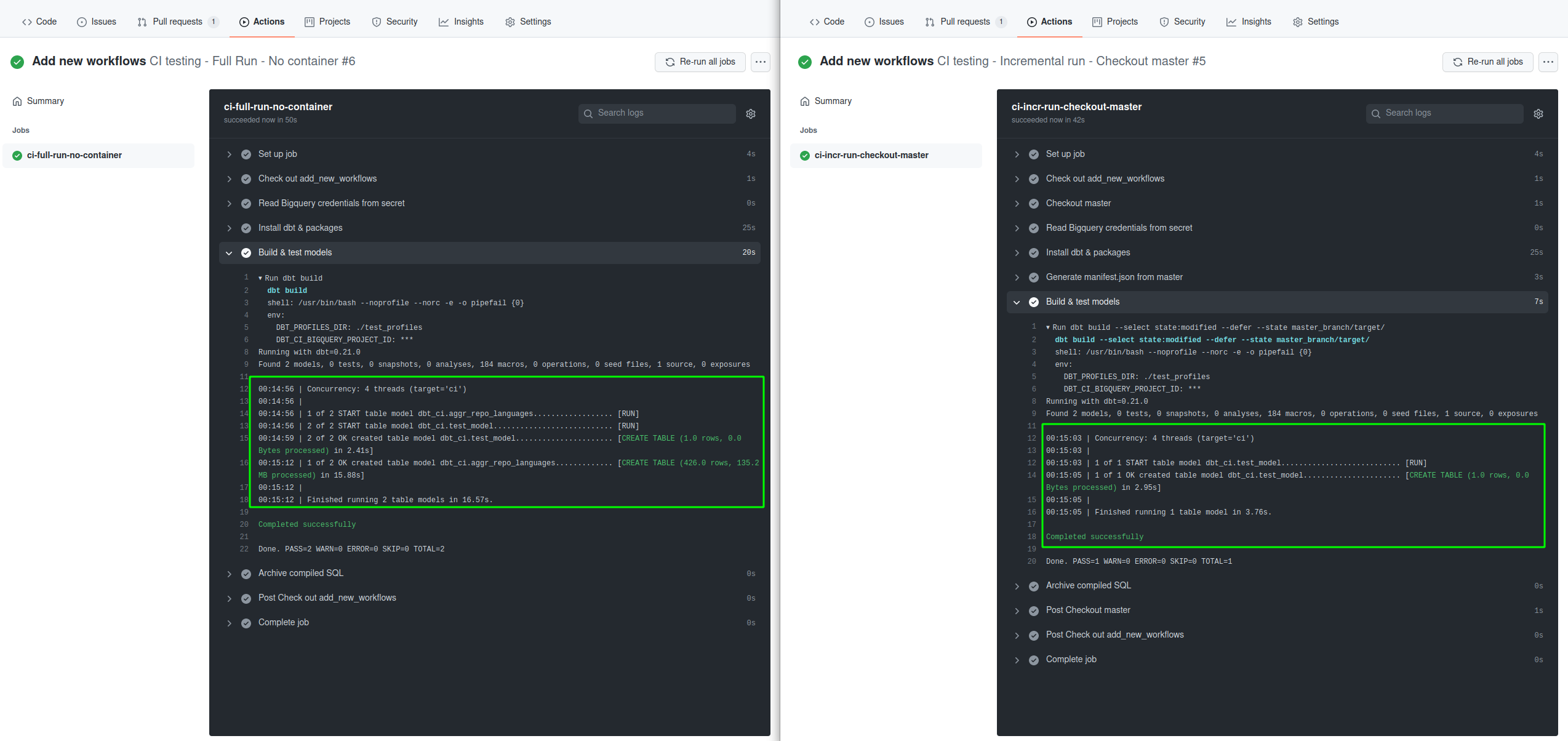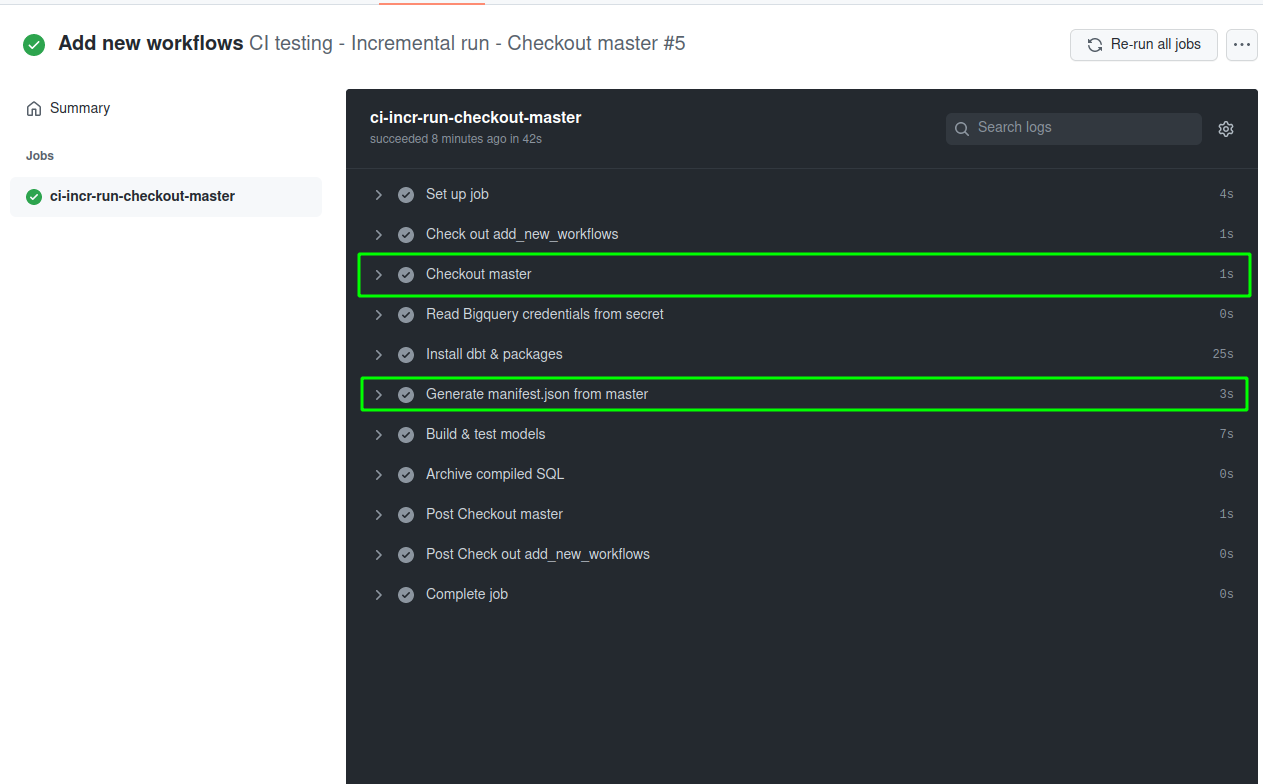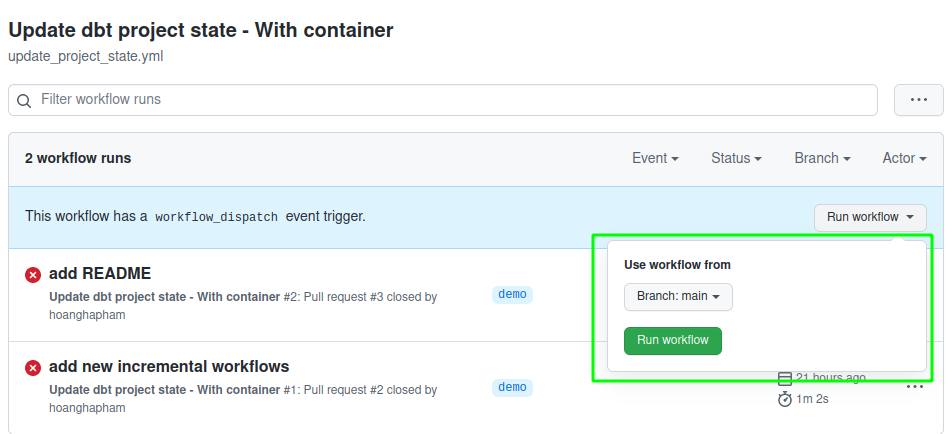If you are familiar with the modern data stack, probably dbt is no stranger. dbt tries to bring the best practices from the software engineering world into data development, and one of such practices is the idea of automated testing and continuous integration (CI).
While dbt Cloud provides a “slim CI” feature that satisfies most basic needs, you will have more control over your CI jobs if you make use of your git provider’s CI/CD functions. In this project, we will look at how to create a dbt CI job using GitHub Actions
The demo project can be found here: https://github.com/hoanghapham/dbt_ci_demo
What is GitHub Action?
GitHub Actions is GitHub’s tool to schedule & execute software development workflows right within your GitHub repository. The workflows are configured using YAML files placing in the .github/workflows folder.
If you are not familiar with the tool, it is best to start with GitHub’s documentation first. This tutorial will assume that you have already grasped the basic concepts of GitHub Actions.
Preparation
Required dbt version: 0.21.0 or above (As of this writing’s date, v0.21.0 is the latest version). dbt 0.21 has introduced the powerful
dbt buildcommand that you should definitely use.dbt project setup: dbt stores information about database connections in the
profiles.ymlfile. In this tutorial, we will place the file in atest_profilesfolder.Database: In this tutorial, I will use a free Google BigQuery account. You can easily register for one yourself following this instruction. If you decide to use BigQuery, you will also need to create a Service Account, and download the key following this instruction.
Actions secrets: Important information like credentials, passwords, access tokens… must not be committed to the repository. Instead, you can set them up as Action secrets.

With that out of the way, let’s dive in.
Run a workflow upon PR creation
First, let’s configure a job to run upon a new PR against the main branch.In general, the workflow will need to have the following steps:
- Check out the code branch you have just pushed
- Read the database credentials from the repository’s secret
- Install dbt to the GitHub action runner, as well as necessary packages
- Build & test dbt models
- Archive the compiled SQLs for debugging purpose
Suppose that our profiles.yml has a ci target like so:
demo_ci:
target: ci
outputs:
ci:
type: bigquery
method: service-account
project: "{{ env_var('DBT_CI_BIGQUERY_PROJECT_ID') }}"
dataset: dbt_ci
keyfile: ./test_profiles/cred.json
threads: 4
timeout_seconds: 300
priority: interactive
Our basic workflow will look like this:
name: CI testing - Full run - No container
on: [pull_request] # Run this workflow when there is a new PR
jobs:
ci-full-run-no-container:
runs-on: ubuntu-latest
env:
DBT_PROFILES_DIR: ./test_profiles # Tell dbt to look for profiles in this folder
DBT_CI_BIGQUERY_PROJECT_ID: ${{ secrets.DBT_CI_BIGQUERY_PROJECT_ID }} # Make the BigQuery project ID available as an env var
steps:
- name: Check out ${{ github.head_ref }}
uses: actions/checkout@v2
- name: Read Bigquery credentials from repo secret
shell: bash
env:
DBT_CI_BIGQUERY_CRED: ${{ secrets.DBT_CI_BIGQUERY_CRED }}
run: |
mkdir -p ./test_profiles;
echo $DBT_CI_BIGQUERY_CRED | base64 -d -i > ./test_profiles/cred.json
# Need to install dbt into the runner
- name: Install dbt & packages
shell: bash
run: |
pip3 install dbt==0.21.0;
dbt deps;
- name: Build & test models
shell: bash
run: dbt build
# Upload compiled SQL as artifacts
- name: Archive compiled SQL
if: ${{ always() }}
uses: actions/upload-artifact@v2
with:
name: compiled_sql
path: ./target/compiled
A few notes:
After the job finishes running, the runner will be destroyed. All resources created in the runner (checked-out codes, new files created…) will also be destroyed, unless you upload them as artifacts.
In the Read credential step, since I encoded my credentials using
base64before adding it into the secrets, I needed to decode it before putting it into acred.jsonfile.In the final step (Archive compiled SQL), the
if: ${{ always() }}expression ensures this step will always run, even when the previousdbt buildstep fails (because of a failed test, or an invalid dbt run). This step will make the compiled SQL available to you after the job finished running.
After merging this workflow, whenever you make a new PR against your main branch, the workflow will be triggered. The GitHub UI will show you which workflows are running, just like when you enable Slim CI in dbt.


Incremental testing workflow
The problem with the workflow above is that, even when you only modify one model, the whole project will be rebuilt when you invoke dbt build. This can result in an expensive (as in, cost you more BigQuery money) and slow-running workflow.
To avoid this, you can use dbt’s state and defer feature to compare your current project with a previous state, and only run the new and modified models.
The state of a dbt project is reflected in the manifest.json file. When you run some dbt commands (like compile, run, test…) this file will be generated into the target folder. By default, this folder is ignored and not pushed to GitHub, so we need to make this file available in the action runner.

There are a few approaches, each of which has its own pros and cons:
- Manually commit the
manifest.jsonfile - Generate the
manifest.jsonfile at run time - Have an automated workflow to generate and commit the
manifest.jsonfile
After having the manifest file available, you can change the dbt build step into
dbt build --select state:modified --defer --state folder-with-manifest-file/
Let’s go into the details of the approaches below.
Manually commit the manifest file
You can either:
Add
!target/manifest.jsoninto the.gitignorefile so that everything in thetargetfolder will be ignored except themanifest.jsonfile. This way, every time you run a dbt command and the state of your project changes, you can commit that change.This is also the drawback of this approach, since during model development, it is unnecessary to commit all the tiny changes. In the GitHub Actions workflow, you will also need a step to copy the manifest file to a different location other than the
targetfolder before running a new dbt command.Or, manually copy the
manifest.jsonfile to a different location only when necessary. This way you have better control of which state to retain, but of course, you have to remember to do it every time you push something new to your repository.
The advantage of this approach is that it is the easiest to do. However, it is quite cumbersome, and is definitely not cool. We are here to do cool stuff, so let’s automate this process.
Automatically generate manifest file at run time
One way to have the manifest file reflecting the old project state is to generate it directly from your main branch. Here’s the workflow to do so:
name: CI testing - Incremental run - Checkout master
on: [pull_request]
jobs:
ci-incr-run-checkout-master:
runs-on: ubuntu-latest
env:
DBT_PROFILES_DIR: ./test_profiles
DBT_CI_BIGQUERY_PROJECT_ID: ${{ secrets.DBT_CI_BIGQUERY_PROJECT_ID }}
steps:
- name: Check out ${{ github.head_ref }}
uses: actions/checkout@v2
# Check out master branch to a different folder
- name: Checkout master
uses: actions/checkout@v2
with:
ref: master
path: master_branch/
# Should also copy the credential into the master_branch folder
- name: Read Bigquery credentials from secret
shell: bash
env:
DBT_CI_BIGQUERY_CRED: ${{ secrets.DBT_CI_BIGQUERY_CRED }}
run: |
mkdir -p ./test_profiles;
echo $DBT_CI_BIGQUERY_CRED | base64 -d -i > ./test_profiles/cred.json;
echo $DBT_CI_BIGQUERY_CRED | base64 -d -i > ./master_branch/test_profiles/cred.json;
- name: Install dbt & packages
shell: bash
run: |
pip3 install dbt==0.21.0;
dbt deps;
- name: Generate manifest.json from master
shell: bash
run: dbt compile --project-dir master_branch/ --profiles-dir master_branch/test_profiles/
# Tell dbt to look up previous manifest file in master_branch/target
- name: Build & test models
shell: bash
run: dbt build --select state:modified --defer --state master_branch/target/
- name: Archive compiled SQL
if: ${{ always() }}
uses: actions/upload-artifact@v2
with:
name: compiled_sql
path: ./target/compiled
How this workflow is different from the previous one:
- First, we check out the files from our
masterbranch to themaster_branchfolder within the current project - Then, we generate the manifest file from the master branch by running
dbt compile, while specifying the project directory asmaster_branch/. The manifest file will be generated intomaster_branch/target/folder. Note that it is necessary to also copy the credential file into themaster_branchfolder. - Finally, run
dbt buildwhile pointing to themaster_branch/target/folder for state comparison
As you can see, in the incremental workflow, only the new test_model.sql file is run, while the original full run workflow will run all the files.

So we have started to automate the boring stuff! However, this workflow has a drawback. Every time you push something new to an opened PR, the whole checkout and generate manifest steps will have to run again.
This may be OK if your project is small, but it may cost you more job run time if your project has hundreds of models.

We can certainly flex further and look for a way to reuse this manifest file.
Generate manifest file when merging to main branch
During model development, it is unlikely that the manifest file will change that much. We would want to reuse this manifest file, but GitHub Actions does not allow sharing files between different job runs.
We can work around this with workflow that update the manifest file when you merge a new PR. This is the workflow that do so:
name: Update dbt project state
on:
pull_request:
types: [closed]
workflow_dispatch:
jobs:
update-project-state:
if: github.event.pull_request.merged == true
runs-on: ubuntu-latest
env:
DBT_PROFILES_DIR: ./test_profiles
DBT_CI_BIGQUERY_PROJECT_ID: ${{ secrets.DBT_CI_BIGQUERY_PROJECT_ID }}
steps:
- name: Checkout master
uses: actions/checkout@v2
with:
ref: master
- name: Read Bigquery credentials from secret
shell: bash
env:
DBT_CI_BIGQUERY_CRED: ${{ secrets.DBT_CI_BIGQUERY_CRED }}
run: |
mkdir -p ./test_profiles;
echo $DBT_CI_BIGQUERY_CRED | base64 -d -i > ./test_profiles/cred.json;
- name: Install dbt & packages
shell: bash
run: |
pip3 install dbt==0.21.0;
dbt deps;
- name: Generate manifest.json from master
shell: bash
run: |
dbt deps;
dbt compile --no-version-check;
mkdir -p ./current_state;
cp ./target/manifest.json ./current_state/manifest.json;
- name: Commit new manifest.json file
uses: EndBug/[email protected]
with:
add: './current_state/manifest.json'
message: 'manifest.json updated'
push: true
branch: master
This part:
on:
pull_request:
types: [closed]
workflow_dispatch:
jobs:
update-project-state:
if: github.event.pull_request.merged == true
runs-on: ubuntu-latest
specifies the types of events that will trigger this workflow.
pull_request: This workflow will run when you merge a PR to the master branch (defined with theifexpression).workflow_dispatch: This means that you can also manually trigger this workflow from GitHub Action’s UI.
After this, in the main CI workflow you can remove the “Checkout master” and “Generate manifest file from master” steps. Since we now have the manifest.json file in the current_state folder, when running dbt build you need to point to this folder for state comparison.
dbt build --select state:modified --defer --state current_state/
Bonus: Run jobs inside a container
In the workflows above, we have a step to install dbt into the runner:
pip3 install dbt==0.21.0
You can also run dbt using dbt Labs’ official Docker image so you won’t need to worry about dependencies. Simply add the container and image properties to the job config:
jobs:
ci-incr-run:
runs-on: ubuntu-latest
container:
image: fishtownanalytics/dbt:0.21.0
Now you can remove the pip3 install dbt==0.21.0
Conclusion
Hope that this demonstration can help others who are trying to improve their dbt workflow. If you have any comments or questions, please create an issue in this repo: https://github.com/hoanghapham/dbt_ci_demo.
